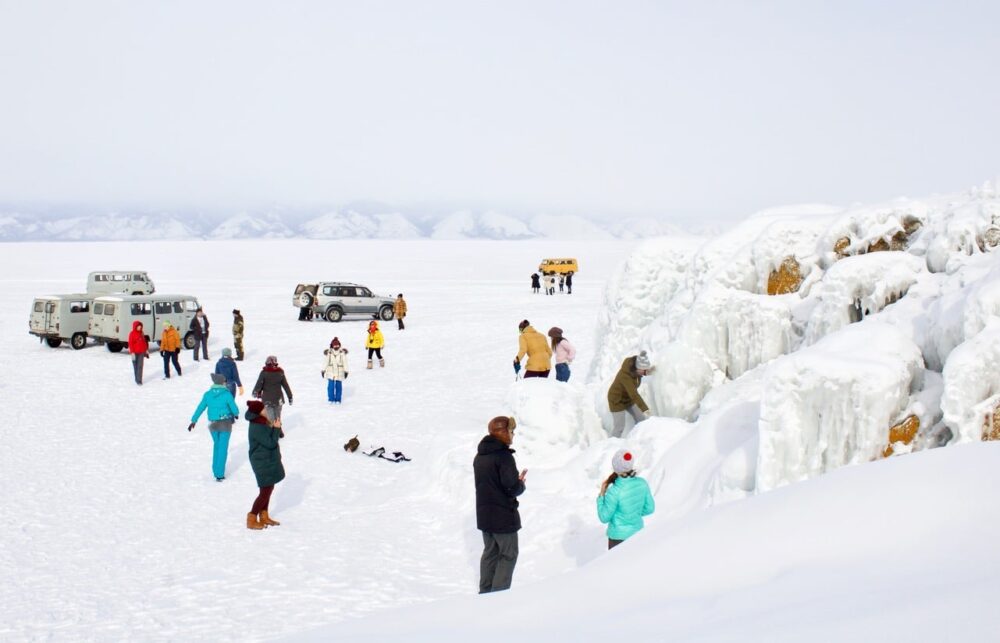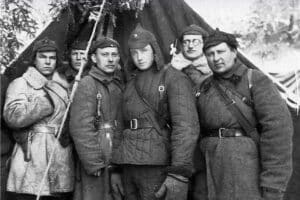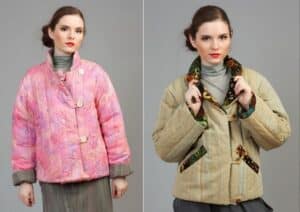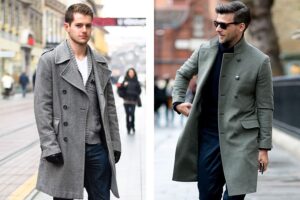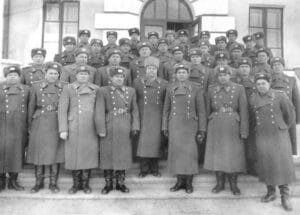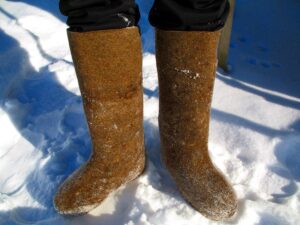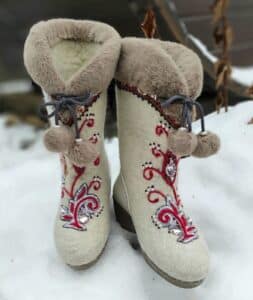Russia has famously cold winters. Russians, and the many other cultures that live across the Eurasian landmass (such as the Evenk and Sakha), have culturally adapted to this in order to survive there. This has affected traditional clothing and housing, but also cultural attitudes toward the weather. These attitudes are, in turn, often reflected in language. This article will explore these attitudes, linguistic expressions, and modern clothing trends among Russians. It will also present Russian vocabulary related to cold, clothing, and social standing shown by fashion.
The following bilingual Russian resource is meant to build your vocabulary by providing Russian phrases within English text.
Russian Sayings about Being Prepared for the Cold
The Russian language has developed some coping responses to the weather. Probably the most affirming of them is “У природы нет плохой погоды,” which literally means “Nature doesn’t have bad weather.” This saying is used in the context that one should roll with the punches and that everything happens for a reason.
Also reassuring is “в зимний холод всякий молод” meaning “everyone is young in winter’s cold.” Literally, it refers to the rosy cheeks caused by blood initially rushing to them to keep them warm.
There is also the more ominous “Мороз не велик, но стоять не велит” meaning “It’s not tremendously cold, but we shouldn’t stand in it.” Perhaps ironically, it refers to being conscious of the same process that can affect the proverbial boiled frog. And, indeed, frostbite and hypothermia tend to come on slowly and can take their victims before they even know they are being taken.
Perhaps the saying most relevant to this article, however, is an English proverb that has been very well known in Russian translation for decades: “Нет плохой погоды, есть неподходящая одежда.” This literally means “there is no bad weather, only inappropriate clothing.” It can be used poetically to express the virtues of always being prepared but usually means exactly what it says: if you dress appropriately, there is no weather you can’t enjoy.
The Timelessness of Fur in Russia
Самое теплое зимнее пальто (the warmest winter coat) has always been шуба из натурального меха (a coat of natural fur). Fur coats have always been relatively common in Russia. Russia’s thick forests have historically been home to many animals that provide quality fur. The meat from these animals provided important sources of protein to most common households and their furs were worn or used as a common form of currency. Taxes or required tributes were often paid in furs, which the tsar could then trade on to Europe for other goods.
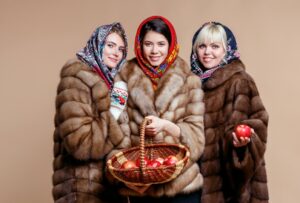
Today, fur coats are most often purchased rather than hunted and crafted. They are by far the most expensive coat option that Russians have. However, they are still very common and very popular in Russia. The anti-fur movement has made little headway in dissuading most Russians from what they consider a very practical and comfortable choice of clothing. Also, the fur coat is by far the most durable coat choice available. При правильном уходе шуба может носиться десятилетиями (If properly cared for, a fur coat can be worn for decades) – and it often is.
Образ жены, требующей от мужа шубу, широко распространен в русской культуре (the image of a wife demanding a fur coat from her husband is a common one in Russian culture). Шуба – символ статуса (The fur coat is a status symbol) and one that is attainable by most middle-class Russians.
When choosing a material for a coat, some of the самый тёплый мех (warmest fur) is that of бобер (beaver), норка (mink), соболь (sable), and олень (deer). Качество меха (fur quality) can be assessed by встряхивать шубу (rustling the fur coat). You should be able to hear the шуршание (rustling), distinctly. Another test is to легонько дёрнуть за шерстинку (pluck lightly on a strand). Если волоски не отрываются (if no hair comes out), it means that the fur is of good quality.
Military Roots and Social Derision of the “Cotton Coats”
Зимнее пальто, наиболее ассоциирующееся с низшим классом людей – это ватник (the winter coat most associated with the lowest class of people is the “vatnik”), which is a type of pleated, cotton-padded coat. Cotton is not as good an insulator as fur or down but is still effective. This coat is more formally known as “телогрейка” (“bodywarmer”). However, ватник, taken from the word вата (cotton), is very commonly used.
This type of coat was used by the Byzantine Army in the 10th century and was likely adopted in Russia from the 11th-12th centuries, but then fell out of favor around the time of the Mongol invasion.
The coat was reintroduced during the Russo Japanese War in 1905. Poorly equipped Russian soldiers acquired them from the Chinese and found that, not only were they warm, but they also служили легкой броней в рукопашном бою (provided light armor in hand-to-hand combat), with the soft cotton providing padding against blows and the thick material providing protection even from knife attacks. In addition, the coat is loose and обеспечивает неограниченную свободу движений владельца (provides unrestricted movement to the wearer). This was all part of the original Byzantine purpose of the coats – and may be why military investment in them ended with the Mongols – as the coats are completely ineffective against arrows, the Mongol’s primary weapons.
The jackets were used in the First World War and the Civil War but пальто были стандартизированы и массово производились (the coats were standardized and mass produced) only starting in 1933. Народного комиссариата легкой промышленности СССР (The People’s Commissariat of Light Industry) issued a decree that they would be manufactured as куртка ватная однобортная, прямого покроя, застёгивается по борту доверху на 4 пуговицы имеющимися в левом борте четырьмя пришивными петлями (a single-breasted cotton-padded jacket, straight cut, fastened on the left side up to the top by four buttons and with four sewn-in belt loops).
These coats then стали стандартной одеждой для армии и тюремных лагерей (became standard issue for the army and for prison camps). Anyone exiting these institutions would generally do so with the vatnik and, если им нечего было надеть, они продолжали носить ватник (if they had nothing better to wear, they would keep wearing the vatnik).
Throughout this history, the coat became the clothing of choice for criminals. Commonly worn, they blended in well, assisted in fights and allowed for quick movement.
Because the прочно ассоциируется в основном с сельскими, более бедными и менее образованными людьми, (is very strongly associated with rural, poorer, less educated people), the term “ватник” is actually used to refer to the people who wear them in a derogatory term roughly equivalent to the American “red neck.”
Other Types of Winter Coats in the USSR and Modern Russia
Today, и шуба, и ватник по-прежнему часто встречаются (the fur coat and vatnik are still commonly seen). Vatniki can also be found in more stylish versions than the Soviet-era standard, and marketed under the official name: “телогрейка.”
In the Soviet era, мужчины и женщины обычно носили шинель из шерстяного сукна (men and women commonly wore a woolen cloth overcoat) с подкладкой из ватина и меховым воротником (with a cotton lining and a fur collar). If a person wanted to look more fashionable, he/she мог носить не шинель, а дубленку (might have worn a sheepskin coat rather than the overcoat).
Today, these too can still be found, along with a much greater assortment of choices. Одним из самых популярных современных пальто является качественный пуховик (One of the most popular modern coats is the high quality down-padded coat). This coat will usually have a синтетический внешний слой (synthetic outer layer) but will be stuffed with натуральный пух (natural down). This is considered to be самое теплое пальто после шуб (the warmest coat next to fur coats) and can also be one of the least expensive options.
Куртка на синтетическом утеплителе (a jacket with synthetic heat insulation material), while popular in the west, is one of the least practical options for living through a harsh winter. Synthetic material can insulate well, but not for anywhere near as long as natural down.
Another option, which was also not widely available under the USSR, but в настоящее время все большую популярность среди модников приобретает кашемировое пальто (now more popular among the fashion conscious is the cashmere coat).
Winter Footwear for the Eurasian Cold
Зимние ботинки необходимы (winter boots are essential). The best quality are leather and lined with insulation. Они часто покупаются на размер больше (they will often be bought a little larger) that other shoes so that в них можно разместить толстые зимние носки (they can accommodate thick winter socks), perhaps worn as an extra pair over regular athletic socks. Ensuring that the cold of the ground does not reach the feet is essential to being able to stay outdoors in freezing temperatures safely and comfortably.
Россияне обычно предпочитают зимние высокие сапоги (Russians generally favor winter high boots) из кожи с внутренней подкладкой из натурального меха (made of leather with an inner lining of natural fur). Ботинки должны быть водонепроницаемыми и иметь хорошее сцепление с поверхностью (boots should be waterproof and have good traction), although Russian women are famous for being able to high-heeled winter boots even when the streets have largely turned to ice.
Winter boots must be high quality and за ними необходимо правильно ухаживать (they must be properly cared for), especially in major cities where улицы заполнятся кашей (the streets will fill with “kasha”). “Каша” is the Russian word for “porridge” and is used in slang to refer to the brown-grey slush that forms when snow, dirt, pollution, and anti-ice reagent all mix. The compound can be deadly for shoes.
Самыми традиционными зимними сапогами уже давно стали валенки (the most traditional winter footwear has long been valenki). Early forms of valenki were formed from pieces of felt rolled into form and sewn along the side into a sort of shoe. This technology is very old and has long been widespread – Plato writes of ancient Greeks wearing similar winter footwear.
Valenki as they are now known were likely adapted from the Mongols and are based on a felt sock that warriors wore within their boots. Валенки изготавливаются из цельного куска формованного войлока, длина которого достигает чуть ниже колена (valenki are formed from single piece of molded felt that reaches just below the knee). This design is excellent for walking through high snow but was initially prohibitively expensive. Not only is forming the single piece a highly specialized skill, requiring specialized equipment, but a set of these boots will often contain an entire kilogram or more of wool – that is, an entire sheep’s worth.
The newer model became widespread only in the later 19th century, when several factories were built specifically to produce them after the tsar made the boots part of the uniform for his soldiers. By 1900, about 1.5 million pair were produced and sold annually within the Russian empire. The USSR carried on this tradition, as does modern Russia.
Today, на валенки часто надевают галоши (valenki are often fitted with “galoshi”), a protective rubber outer portion that the Soviets developed. Some models have soles embedded into the material.
Although дизайнерские валенки сегодня популярны в городах (designer valenki are now popular in cities), they are more associated with village life and can be associated with the qualities of the vatnik, although to a far lesser extent. This can be seen in the expression тупой, как сибирский валенок (as stupid as a Siberian felt boot), used to refer to something stupid and clumsy. Valenki are soft and edgeless and thus not as “sharp” as other footwear more commonly worn in cities. You might also notice too that the expression uses the singular for valenki, valenok. Having just one boot does no one any good.
Although not as common, унты – еще один вид традиционной обуви (“unti” are another form of traditional footwear). These are fur shoes. The oldest versions would, like older versions of valenki, be simply a piece of material rolled and sewn up the side with the leather side out and fur side in. These can also be seen on modern streets in designer versions. However, these are far more expensive than valenki and less practical, especially if the ground is wet and dirty.
Basic Principles of Staying Warm
One of the most important principles in staying warm is to keep as much of the body’s own warmth next to it while not causing the body to sweat. Moisture will decrease clothing’s ability to insulate you and any exposed skin with moisture will be at greater risk of temperature loss and frostbite.
Thus, одежда должна быть многослойной (clothes should have many layers). Лучше иметь два тонких свитера и одну тонкую водолазку (It is better to have two thinner sweaters and one thin turtleneck), than one very thick sweater. This creates more layers of air between you and the elements – which is what, in the end, will keep your body’s warmth contained.
One must especially беречь конечности (protect one’s extremities). First of all, this includes the голова (head). Without a good hat, heat loss from the head is substantial, placing the rest of the body at risk. Для очень холодной погоды лучше всего подходят шапки с кожаной и меховой подкладкой (For deep cold, the best hat is leather and fur lined). However, such a hat can easily cause one to sweat if temperatures are not low enough. Вязаные шапки лучше использовать в более легкую погоду (knit caps are better for lighter weather).
When cold, blood is removed from the limbs to the heart and brain, protecting the body’s core, but making the limbs more vulnerable to frostbite. The fingers, nose, and ears are especially vulnerable as they have fewer blood vessels and less mass with which to hold onto their heat. Thus, необходимы теплые перчатки или варежки и шарф (warm gloves or mittens and a scarf are needed). Следует также носить ушные вкладыши или шапку, закрывающую уши, например, ушанку (earmuffs or a hat able to cover the ears, such as an “ushanka” should also be worn).
Lastly, you must realize that body’s ability to maintain its temperature relies on its ability to burn calories. The body will work harder and burn more calories in the cold just to maintain its temperature. Thus, Russian врачи не советуют выходить на улицу голодным (doctors don’t advise people to go outside hungry). In winter, one should повысить калорийность рациона (increase the calorie content of one’s diet) by adding more meat, fish, and fat.
This is also the reason why some Russians will insist that полезно пить водку зимой (it is good to drink vodka in the winter). The alcohol not only создает ощущение тепла в организме (gives the body a sensation of warmth) as it is drunk, but it also very high in calories, supplying about 100 with every 50-gram shot. At a time when other caloric sources are more limited, this might be useful to sheer survival. However, it is not recommended as the alcohol also dulls the senses, reducing the body’s ability to alert you to the onset of hypothermia and frostbite. Thus, эта привычка также ассоциируется с более бедными и менее образованными людьми (this habit too is associated with poorer and less educated people).
Conclusion: Culture Adapts to Cold
Much more could be said about the weather of Eurasia and how people and cultures have adapted to it (including mentioning that Eurasia also has surprisingly hot summers!)
Adapting to the cold has left Russian culture and society with a particular reverence for dressing for the weather, a highlevel of cultural knowledge about how the body reacts to cold, and with some habits and styles that are particularly associated with socio-economic class.
You’ll Also Love
Posts not found

